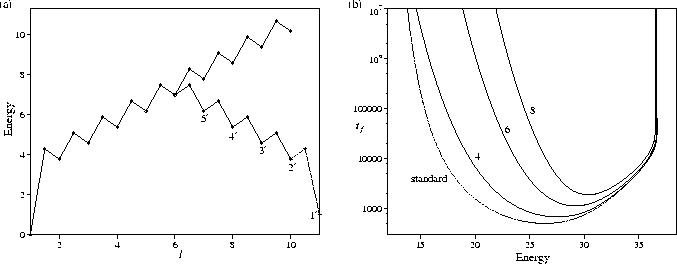In this section we investigate the effect of making ![]() dependent on l.
In particular, we reduce the number of connections between l=1 and l=2, and between l=2 and l=3.
Such a PES is illustrated in Figure 5.8a; it has
dependent on l.
In particular, we reduce the number of connections between l=1 and l=2, and between l=2 and l=3.
Such a PES is illustrated in Figure 5.8a; it has ![]() and
so only 1 in 3 of the minima in level 3 are connected to a minimum in level 2.
These changes do not affect the thermodynamics in any way (including the Landau entropy)
but instead produce a kinetic bottleneck.
In Figure 5.8b, the dependence of the folding time
for the modified surface upon
and
so only 1 in 3 of the minima in level 3 are connected to a minimum in level 2.
These changes do not affect the thermodynamics in any way (including the Landau entropy)
but instead produce a kinetic bottleneck.
In Figure 5.8b, the dependence of the folding time
for the modified surface upon ![]() is shown.
tf increases as the number of connections is reduced, but at the most by only one to two
orders of magnitude. The slowing down of the dynamics at the bottleneck leads first to local equilibrium
above the bottleneck (Figure 5.8c) and to a build-up of probability in level 3 and to
a lesser extent in levels 4 and 5 (Figure 5.8d).
is shown.
tf increases as the number of connections is reduced, but at the most by only one to two
orders of magnitude. The slowing down of the dynamics at the bottleneck leads first to local equilibrium
above the bottleneck (Figure 5.8c) and to a build-up of probability in level 3 and to
a lesser extent in levels 4 and 5 (Figure 5.8d).
These results show that kinetic bottlenecks may significantly affect the folding rate, but to a smaller extent than other factors, such as the slope of the funnel or the multiple funnels that we shall consider next. Kinetic bottlenecks may be important in rationalizing the detailed dynamic behaviour of a particular system, but are unlikely to represent the difference between, for example, folding and non-folding proteins.
 |